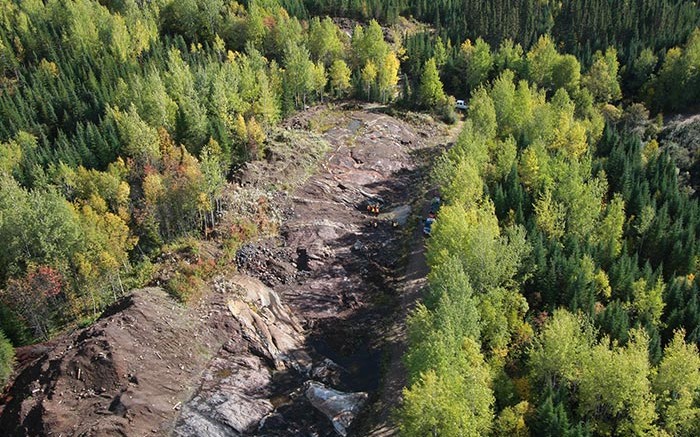Arianne Phosphate’s (TSXV: DAN; US-OTC: DRRSF) chief operating officer, Jean-Sébastien David, is on a mission to cut anticipated operating expenses at the company’s Lac-à-Paul phosphate project in Quebec by US$10 per tonne from the US$93.60 per tonne envisioned in an October 2013 bankable feasibility study — and he’s more than halfway there.
In May last year, metallurgical test work showed that Arianne could eliminate two reagents — starch and sulphuric acid — from phosphorous pentoxide (P2O5) processing, cutting opex by US$3.91 per tonne.
The company announced that changes to its mine plan would deliver opex savings of US$4.26 per tonne — bringing the combined cost savings to US$8.17 per tonne.
In addition, plans are afoot to switch from diesel to liquefied natural gas (LNG) as the fuel of choice for Arianne’s planned fleet of 61 trucks, which would move the P2O5 from the mine to a port in Quebec City.
David says he will submit an application to the provincial government that would qualify Arianne for a 20% reduction of the existing preferential electricity rate, a policy move the Quebec government announced last October that will apply to all new industrial plants and large consumers of electricity.
The preferential rate in the province is 4.3¢ per kilowatt hour, David says, and if Arianne can qualify for the lower rate, that would whittle the project’s future electricity costs down to 3.8¢ per kilowatt hour.
The Lac-à-Paul phosphate deposits, 200 km north of Quebec’s Saguenay–Lac-Saint-Jean area, would produce a high-quality, igneous apatite concentrate grading 39% P2O5.
The most recent projected opex cut of US$4.26 per tonne represents a cost savings of almost 5%, and based on the feasibility study, should result in annual savings of US$12.75 million, or nearly US$330 million over the planned 26-year mine life.
The opex cut stems from a decision to start mining via an open pit at the western part of the deposit where this is less overburden.
Under the new mine plan, Arianne thinks the pit will be 400 metres wider than what was envisioned in the bankable feasibility study, reducing the strip ratio from 1-to-1.14 to 1-to-0.88.
David says the company did not update the bankable feasibility study with the new mine plan because it could have cost the company up to US$3 million, and he didn’t see the point.
“There was no value for us,” he explains in a telephone interview from Chibougamau in central Quebec. “With the resource we have and all of the potential targets around the site, it’s easy for major companies or a bank to understand that this project will have a longer mine life than 26 years … it’s pretty easy to see all the blue sky of this project.”
The company also announced in late January that it will make its first presentation on Feb. 18 on the environmental impact and economic benefits of the project to the Bureau d’audiences publiques sur l’environnement (BAPE), an independent agency of the Quebec government. This begins Arianne’s public information and consultation process to receive environmental permitting for Lac-à-Paul.
By Arianne’s estimates, the project is expected to create more than 2,200 direct and indirect jobs during the construction phase and about 1,000 jobs during the mine life. It estimates the project will pioneer a new industry in the province while generating US$1 billion in employment income and more than US$12.6 billion in overall economic benefit for the province.
David says he’s confident the BAPE process will go well, and expects to receive approval in the form of a ministerial decree by August or September of this year, which would help the company prepare the ground for construction by early 2016. There would be other permits needed — such as for water-treatment systems — but David says once a project receives its Ministerial Decree, the other permits typically fall into place.
“After you get the big one, the little ones are easier to get,” he says, adding that he was in charge of permitting the Canadian Malartic mine when he worked as vice-president of sustainable development at Osisko Mining. “Right after we got the big one it took five days to get the first construction permit,” he recalls, adding that permitting at Osisko wrapped up in 18 months.
While he concedes that now permitting takes longer in the province, he is optimistic that he can get it done in a timely manner. “I’ve done it before and I know how it works,” he says.
On financing, David says most of the heavy lifting will really only start after the project receives the ministerial decree. “No permit, no financing,” he says. “If we don’t have the permit, it’s a waste of time for them.”
But David notes that the company “is in close contact with the big players,” and says they recognize the project looks good — not only because of the high-grade P2O5, but also because it is free of impurities such as uranium and cadmium.
“I think it’s well-known that the product coming from our site is high-quality ore,” he continues, noting that by comparison, the phosphate from Morocco is from sedimentary rock containing both impurities.
“People looking for higher quality, for food-grade, cannot take the Moroccan stuff,” he says. The biggest competitor for Arianne’s high-quality ore is actually in Russia, David adds. But the company, PhosAgro, is becoming a more integrated operation, he explains, and they’re “going to put less rock in the market, so that’s another place where we can play by supplying the high-quality rock instead of the Russians.”
David also points out that Arianne is looking to sell its concentrate in Canada and the U.S., which is a market with a 4-million-tonne deficit that is projected to grow to 8 million tonnes by 2020.


Be the first to comment on "Arianne chops opex at Lac–Paul"